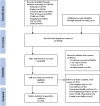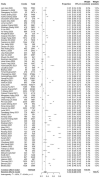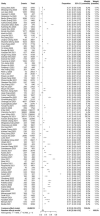The prevalence of psychological stress in student populations during the COVID-19 epidemic: a systematic review and meta-analysis
- PMID: 35840641
- PMCID: PMC9284967
- DOI: 10.1038/s41598-022-16328-7
The prevalence of psychological stress in student populations during the COVID-19 epidemic: a systematic review and meta-analysis
Abstract
Following the COVID-19 outbreak, psychological stress was particularly pronounced in the student population due to prolonged home isolation, online study, closed management, graduation, and employment pressures. The objective of this study is to identify the incidence of psychological stress reactions in student populations following a global outbreak and the associated influencing factors. Four English databases (Pubmed, Embase, Cochrane Library, Web of Science) and four Chinese biomedical databases (Chinese Biomedical Literature Database, VIP Database for Chinese Technical Periodicals, China National Knowledge Infrastructure, Wanfang) were searched in this study. We also retrieved other search engines manually. The search period was from the time of database creation to 10 March 2022. This study included cross-sectional studies related to psychological stress reactions in student populations during the COVID-19 epidemic. Three groups of researchers screened the retrieved studies and assessed the quality of the included studies using the Agency for Healthcare Research and Quality Cross-Sectional Study Quality Assessment Checklist. A random-effects model was used to analyze the prevalence of depression, anxiety, stress, and fear symptoms in the student population during the COVID-19 epidemic. Of the 146,330 records retrieved, we included 104 studies (n = 2,088,032). The quality of included studies was moderate. The prevalence of depressive symptoms in the student population during the epidemic was 32.0% (95% CI [28.0-37.0%]); anxiety symptoms was 28.0% (95% CI [24.0-32.0%]); stress symptoms was 31.0% (95% CI [23.0-39.0%]); and fear symptoms was 33.0% (95% CI [20.0-49.0%]). The prevalence differed by gender, epidemic stage, region, education stage, student major and assessment tool. The prevalence of psychological stress in the student population during the COVID-19 epidemic may be higher compared to the global prevalence of psychological stress. We need to alleviate psychological stress in the student population in a targeted manner to provide mental health services to safeguard the student population.
© 2022. The Author(s).
Conflict of interest statement
The authors declare no competing interests.
Figures





Similar articles
-
Immediate Psychological Responses and Associated Factors during the Initial Stage of the 2019 Coronavirus Disease (COVID-19) Epidemic among the General Population in China.Int J Environ Res Public Health. 2020 Mar 6;17(5):1729. doi: 10.3390/ijerph17051729. Int J Environ Res Public Health. 2020. PMID: 32155789 Free PMC article.
-
Psychological distress surveillance and related impact analysis of hospital staff during the COVID-19 epidemic in Chongqing, China.Compr Psychiatry. 2020 Nov;103:152198. doi: 10.1016/j.comppsych.2020.152198. Epub 2020 Aug 12. Compr Psychiatry. 2020. PMID: 32980595 Free PMC article.
-
Prevalence of depressive symptoms among Chinese university students amid the COVID-19 pandemic: a systematic review and meta-analysis.Epidemiol Psychiatr Sci. 2021 Mar 26;30:e31. doi: 10.1017/S2045796021000202. Epidemiol Psychiatr Sci. 2021. PMID: 33766163 Free PMC article.
-
Prevalence of anxiety symptoms among Chinese university students amid the COVID-19 pandemic: A systematic review and meta-analysis.Heliyon. 2022 Aug;8(8):e10117. doi: 10.1016/j.heliyon.2022.e10117. Epub 2022 Aug 10. Heliyon. 2022. PMID: 35965987 Free PMC article. Review.
-
Prevalence of Depression and Anxiety in Nurses during the First Eleven Months of the COVID-19 Pandemic: A Systematic Review and Meta-Analysis.Int J Environ Res Public Health. 2022 Jan 20;19(3):1154. doi: 10.3390/ijerph19031154. Int J Environ Res Public Health. 2022. PMID: 35162183 Free PMC article. Review.
Cited by
-
A Novel and Integrated Digitally Supported System of Care for Depression and Anxiety: Findings From an Open Trial.JMIR Ment Health. 2023 Jul 24;10:e46200. doi: 10.2196/46200. JMIR Ment Health. 2023. PMID: 37486735 Free PMC article.
-
COVID-19 and common mental health symptoms in the early phase of the pandemic: An umbrella review of the evidence.PLoS Med. 2023 Apr 25;20(4):e1004206. doi: 10.1371/journal.pmed.1004206. eCollection 2023 Apr. PLoS Med. 2023. PMID: 37098048 Free PMC article.
-
Influence of Optimism, Social Support, and Spirituality on COVID-19 Stress in Christian Church Community.Psychiatry Investig. 2023 Feb;20(2):130-136. doi: 10.30773/pi.2022.0243. Epub 2023 Feb 23. Psychiatry Investig. 2023. PMID: 36891597 Free PMC article.
-
The Relationship between Physical Activity and Life Satisfaction among University Students in China: The Mediating Role of Self-Efficacy and Resilience.Behav Sci (Basel). 2023 Oct 27;13(11):889. doi: 10.3390/bs13110889. Behav Sci (Basel). 2023. PMID: 37998636 Free PMC article.
-
Analysis of Factors Affecting Academic Performance of Mathematics Education Doctoral Students: A Structural Equation Modeling Approach.Int J Environ Res Public Health. 2023 Mar 3;20(5):4518. doi: 10.3390/ijerph20054518. Int J Environ Res Public Health. 2023. PMID: 36901528 Free PMC article.
References
Publication types
MeSH terms
LinkOut - more resources
Full Text Sources
Medical

